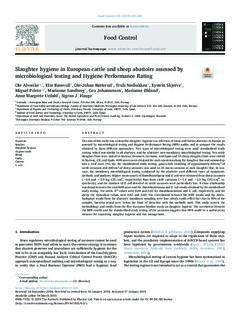| dc.description.abstract | The aim of this study was to describe slaughter hygiene in a selection of ovine and bovine abattoirs in Europe, as assessed by microbiological testing and Hygiene Performance Rating (HPR) audits, and to compare the results obtained by these different approaches. Two types of microbiological testing were used: standardized study testing, which was similar in all abattoirs, and the abattoirs' own mandatory microbiological testing. Ten cattle slaughter lines were visited in Norway, Denmark, Germany, and Spain and 10 sheep slaughter lines were visited in Norway, UK, and Spain. HPR scores were obtained for each operation along the slaughter line and summed up into a total score (%). For the standardized study testing, gauze-cloth swabbing of approximately 800 cm2 of cattle carcasses and 600 cm2 of sheep carcasses was used on 25 warm carcasses at each slaughter line. In contrast, the mandatory microbiological testing conducted by the abattoirs used different types of equipment, methods, and analyses. Higher mean counts of Enterobacteriaceae and E. coli were obtained from sheep carcasses (−0.6 and −0.9 log CFU/cm2, respectively) than from cattle carcasses (−1.4 and −2.5 log CFU/cm2, respectively), and the numbers of E. coli detected on cattle carcasses were particularly low. A close relationship was found between the total HPR score and the Enterobacteriaceae and E. coli results obtained by the standardized study testing. For cattle, R2 values were 0.69 and 0.62 for Enterobacteriaceae and E. coli, respectively, and for sheep the equivalent values were 0.62 and 0.60. The correlations between the HPR results and the microbiological results from the abattoirs’ mandatory sampling were low, which could reflect fact that in 90% of the samples, bacteria tested were below the limit of detection with the methods used. This study reports the methodology and results from the first European baseline study on slaughter hygiene. The correlation between the HPR results and the standardized study testing of the carcasses suggests that HPR could be a useful proxy measure for improving slaughter hygiene and risk management. | nb_NO |

